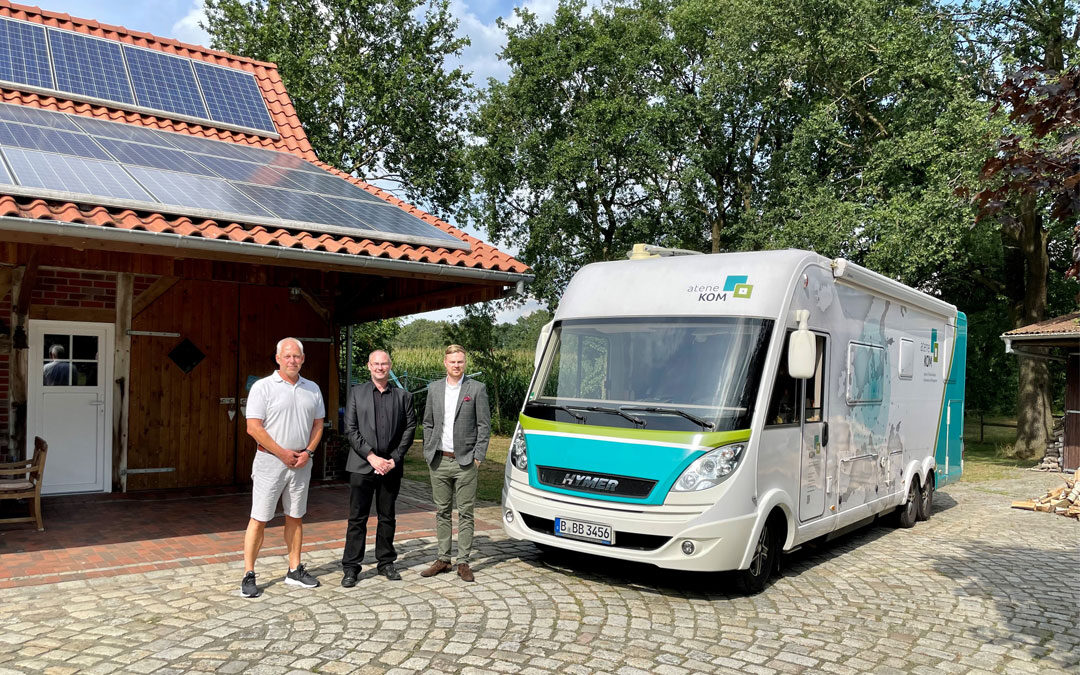What do dairy cows have to do with solar systems? How does this go together with mathematics and what role does artificial intelligence (AI) play in this context? Answers to these and other questions were provided during a stop on the aconium GmbH Future Journey at a “SmartFarm” in Grasberg in the district of Osterholz. There we visited Prof. Dr. Christof Büskens from the Center for Technomathematics at the University of Bremen, who not only explained the technical background to the project, but also outlined the opportunities that come with thinking through concepts and ideas in an interdisciplinary and holistic way, as well as designing them.
Not only do small and medium-sized farms make up a large proportion of the total number of agricultural enterprises in Germany, but they also consume a great deal of electricity and energy during production. In the SmartFarm project launched in 2016, a methodology was therefore developed that allows renewable energies (solar and wind power) to be used profitably for such farms. At the Grasberg SmartFarm, data on the farm’s energy consumption was therefore automatically recorded in a real laboratory using a minimal sensor measurement system. Based on this, highly accurate forecasting models were developed that can predict the production of renewable energy supply systems and the energy consumption of small and medium-sized farms. Based on these calculations, the next step was to determine the best possible design for the energy consumption of agricultural operations using artificial intelligence (AI).
In the current follow-up project, the knowledge gained from the SmartFarm is now to be placed on a broader data basis. In SmartFarm2, the researchers want to identify further potential for optimising energy consumption and put this into practice using 101 real-life demonstrators (dairy farms, pig farms, greenhouses, etc.) as examples. To this end, the farms will be equipped with easy-to-use sensor technology in order to record the high-resolution, time-of-day-dependent consumer and producer data that is not yet available. Based on this data, AI methods and mathematical optimisation algorithms can be used to demonstrate the economic potential of self-consumption optimisation and a highly automated energy management system (EMS) can be developed.
Local agriculture has enormous potential to generate its own energy from renewable sources. However, these can only be stored to a limited extent. And this is where the dairy cow meets the solar system and both meet artificial intelligence. With the help of mathematics, manageable sensor technology and evaluation via AI, energy consumption can be determined in high resolution, not only depending on the time of day. Taking into account all the data collected, an optimal recommendation can now be made as to when the most electricity is produced, when the most electricity should be used and when electricity should be used in the form of batteries, but also thermal energy – such as a cooling system that cools more sustainably or a heat pump that heats more. For example, the idea of using milk to store energy came up. Instead of cooling the milk in the tanks at night using conventionally generated power sources, the milk is instead cooled down more during the day using the more than sufficient solar energy available, so that the milk stored in the tanks is slowly reheated to the optimum temperature overnight. This not only saves energy costs for the farm, but also minimises the use of fossil fuels in the long term. The overriding aim of all measures is to control the farm’s own electricity consumption and storage in such a way that as much self-produced electricity as possible is used in order to have to purchase as little electricity as possible, with the positive side effect of also relieving the burden on the regional electricity grid. An economic and ecological added value for the farm, but also for society.
One of the decisive factors for the successful implementation of the SmartFarm was above all the interdisciplinary cooperation between the university employees on the one hand and the farmers on the other, emphasised Professor Büskens in an on-site discussion with the employees of aconium GmbH. In particular, the different perspectives on things and the different approaches to tackling the challenges arising in the project have resulted in completely new ideas and strategies. Without the joint exchange between agriculture and mathematical science, some connections would not have been obvious, as both sides only ever have one perspective in mind. Only by combining the various strategies and empirical values from theory and practice was it possible to reveal the central added value of the SmartFarm and present the overall picture.
Mathematics meets agriculture: a blueprint that, according to Büskens, cannot be applied to the SmartFarm alone. Although agriculture is primarily an issue in rural areas, it is by no means just one of many other tasks and challenges that need to be overcome. Be it mobility, digital participation or comprehensive medical care. Good solutions are often tested in individual projects, but these usually only deal with partial aspects of a problem or completely ignore other sectors. The mathematician therefore argues that rural areas need to be promoted and rethought more in terms of holistic concepts. He would like to see more “thinking outside the box” and learning from others. Holistic approaches and joint action at a higher level offer the opportunity to strengthen rural areas sustainably and in the long term and to make them worth living in.

